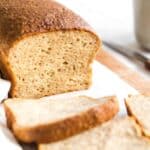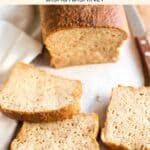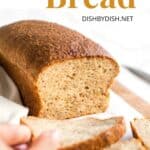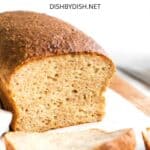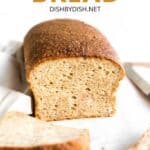Description
Soft, tender and incredibly fluffy, this yeast quinoa bread comes together super easily. With a slightly nutty and earthy flavor, it tastes amazing and is perfect for making sandwiches, or avocado toast, or simply toasted and spread with jam! Totally gluten-free and dairy-free too, but no one would know! Bake a loaf or two and freeze so you can enjoy homemade gluten-free bread anytime!
Ingredients
- 1 3/4 cups gluten-free all-purpose flour
- 1 teaspoon xanthan gum (omit if your gluten-free flour blend already includes it)
- 1/2 cup quinoa flour
- 2 tablespoons psyllium husk powder
- 1 teaspoon baking powder
- 2 1/4 teaspoons instant yeast
- 2 tablespoons sugar
- 1 teaspoon salt
- 1/3 cup sunflower oil
- 1 teaspoon apple cider vinegar
- 1 1/2 cups warm water (approx. 105 to 115F)
- 2 large eggs, room temperature, beaten
Instructions
- Grease the Pan: Grease an 8″ x 4″ metal loaf pan.
- Combine Dry Ingredients: In a large bowl, combine the gluten-free all-purpose flour, xanthan gum (if using), quinoa flour, psyllium husk powder, baking powder, instant yeast, sugar, and salt. Whisk well to combine.
- Add Wet Ingredients to Get Dough: Add the oil, apple cider vinegar, warm water and eggs, and whisk well for a couple of minutes until you get a dough that resembles cake batter (the dough will be sticky and wet, but it’s totally fine).
- Transfer the Dough to the Pan: Transfer the dough to the prepared loaf pan and smooth out the top with a wet spatula.
- Let the Dough Rise: Cover the loaf pan with a kitchen towel and let the dough rise in a warm, draft-free place for 40 to 45 minutes until it has domed and has almost doubled in size.
- Preheat the Oven: During the last 10 minutes of the rise, preheat the oven to 350F.
- Bake Until Golden: Bake the bread for 55 to 60 minutes, until the bread is golden brown and sounds hollow when tapped.
- Cool Completely before Slicing: Allow the bread to cool in the pan for 10 minutes before removing it, and then let it fully cool on a wire rack before slicing into it.
Notes
Gluten-Free All-Purpose Flour: I recommend using a good-quality gluten-free flour blend that is made up of a mix of lighter flours and starches (such as rice flour, corn starch, tapioca starch, or potato starch) to ensure you get a light and fluffy final texture. I do NOT recommend using flour blends that include heavier flours (such as garbanzo bean flour) as it will result in a denser texture.
Xanthan Gum: Xanthan gum replaces the role of gluten in gluten-free flours, and is essential for binding the ingredients together. If your gluten-free flour blend does not include xanthan gum, make sure you add it in.
Quinoa Flour: Since this is a recipe for quinoa bread, quinoa flour is the star here. However, if you don’t have it on hand, you can also use other whole grain flours instead (such as oat flour, sorghum flour, brown rice flour, millet flour, teff flour, buckwheat flour or amaranth flour).
Psyllium Husk Powder: This helps the bread to keep its shape once it has risen and creates a beautiful dome shape that is otherwise hard to achieve with most gluten-free breads, so I do not recommend omitting it. Note that I use psyllium husk powder (which is basically ground whole psyllium husks). If you do not have the powder form on hand, simple grind whole psyllium husks in a coffee grinder or your high-speed blender until it is super fine.
Baking Powder: In this recipe, baking powder (along with instant yeast) helps to give the bread extra lift and rise. If you are Celiac or gluten-intolerant, make sure you use gluten-free baking powder.
Instant Yeast: I like using instant yeast because there’s no need to activate the yeast before hand and can simply mix all the dry ingredients together before adding the wet ingredients. If you do not have instant yeast, make sure you activate the yeast with the sugar and warm water before adding the rest of the ingredients.
Sugar: I used white sugar, but you can also use brown sugar if you prefer. The sugar in the recipe is used for feeding the yeast and giving it energy to activate and create air bubbles that will give the dough rise. Since the amount of sugar used is little and will be eaten up by the yeast, the bread will not be sweet.
Sunflower Oil: I like using sunflower oil because I always have a bottle of sunflower oil on hand. Alternatively, you may also use another vegetable oil (such as olive oil, avocado oil, or melted coconut oil).
Apple Cider Vinegar: The apple cider vinegar creates an acidic environment that reacts with the baking powder (an alkaline product) to create air bubbles and helps the bread to rise. If you don’t have apple cider vinegar, you may also use lemon juice or white wine vinegar.
Water: Make sure the warm water is between 105 to 115F. The yeast requires the warmth to be activated, but if the water is too hot, it will kill the yeast. If you wish to add extra flavor, you may also use non-dairy milks (such as almond milk, cashew milk, rice milk or soy milk). Alternatively, if you are not lactose-intolerant, you may also use normal milk instead.
Eggs: The eggs in this recipe helps the bread to rise and give it structure. I haven’t tried using any egg-replacements or alternatives, so I don’t know how it will turn out. However, if you are allergic to eggs or vegan, you could try using aquafaba or an egg-replacer. (Please let me know how it turns out in the comments if you do make this without eggs!).
Storing/Freezing: To store, place the bread in an airtight container and keep in the refrigerator for up to a week. To freeze, wrap the bread in various layers of plastic wrap or store it in a freezer-safe container and freeze for up to 3 months. Let the bread thaw completely overnight in the refrigerator before slicing into it.
Use a Metal Pan: I strongly suggest using a metal loaf pan to ensure that the bread browns evenly on all sides. Using a glass pan or a ceramic pan will likely result in the bottom not browning well and remaining wet or soggy or even sticking to the pan.
- Prep Time: 5 mins
- Rising Time: 40 mins
- Cook Time: 55 mins
- Category: Bread
- Method: Baking
- Cuisine: American
